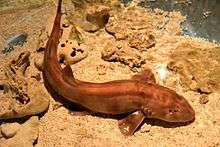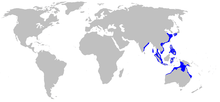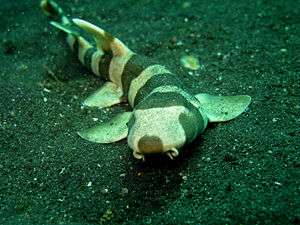Brownbanded bamboo shark
| Brownbanded bamboo shark | |
|---|---|
 | |
| Scientific classification | |
| Kingdom: | Animalia |
| Phylum: | Chordata |
| Class: | Chondrichthyes |
| Subclass: | Elasmobranchii |
| Order: | Orectolobiformes |
| Family: | Hemiscylliidae |
| Genus: | Chiloscyllium |
| Species: | C. punctatum |
| Binomial name | |
| Chiloscyllium punctatum J. P. Müller & Henle, 1838 | |
 | |
| Range of the brownbanded bamboo shark | |
The brownbanded bamboo shark, Chiloscyllium punctatum, is a bamboo shark in the family Hemiscylliidae found in the Indo-West Pacific from Japan to northern Australia, between latitudes 34° N and 26° S, to depths of 85 metres (279 ft). Its length is up to 1.04 metres (41 in). While adults are overall brownish with faint suggestions of bands, the commonly seen juveniles are distinctly barred dark and pale.
Classified as Near Threatened (NT) on the IUCN Red List [1]
Its minimum population doubling is 4.5–14 years range.[2] The major threats to these sharks are the loss of their habitat, pollution, and hunting (both for aquarium trade as well as food).[3]
Reproduction is oviparous.
It is regularly bred in public aquaria, and is arguably the shark most suited to aquaria
Features

Concave posterior margined dorsal fin. No color patterns for the adults but the juveniles have dark transverse bands with some dark spots.[4]
These sharks are nocturnal animals and can survive out of the water for up to 12 hrs. These sharks have barbels, which are sensory organs that look like whiskers. Hence the common name for these sharks is “Cat shark” [5]
Habitat
These sharks live around coral reefs and tide pools.
Sharks as pets
The minimum size of the tank that can carry an adult cat shark is about 180 gallons. Because these sharks are nocturnal species they will need some type of shaded area within the tank where the shark could hide. Although these sharks do not swim around too much, it is highly suggested that the items within the tank should be stable; cat sharks are very strong and will knock down anything that is not stable inside the tank. Also this shark should not be placed with Triggers and Puffers, they will nip at the shark’s fins, nor should they be placed with aggressive feeders.[6]
Feeding
These sharks are carnivores that should be fed 2-3 times a week; some of their diet includes fresh shrimp, scallop, squid, and marine fish. Along with the food, these sharks should take some iodine supplements to prevent goiter disease. Two things to be aware of when feeding the shark: one is to make sure that the meals are bite-sized or else it will throw it back up and the second is sometimes juveniles are difficult to get to eat so adding a flavor enhances their interest .[7]
See also
References
- ↑ Unknown, . "Chiloscyllium punctatum." International Union for Conservation of Nature and Natural Resources. N.p., 2010. Web. 15 April 2010. <http://www.iucnredlist.org/apps/redlist/details/41872/0/>.<
- ↑ Unknown, . "Cat shark – Chiloscyllium punctatum." Aquatic community. N.p., 2008. Web. 27 April 2010. <http://www.aquaticcommunity.com/sharkfish/catshark.php>.
- ↑ Unknown, . "Chiloscyllium punctatum." International Union for Conservation of Nature and Natural Resources. N.p., 2010. Web. 15 April 2010. <http://www.iucnredlist.org/apps/redlist/details/41872/0/>.
- ↑ Compagno, Leonard. "Sharks of the world." Shark Research Center Iziko-Museums of Cape Town. NO. 1. Vol 2. Cape Town South Africa: FOOD AND AGRICULTURE ORGANIZATION OF THE UNITED NATIONS, 2002. Pg 160-195
- ↑ Unknown, . "Banded Cat Shark (Brownbanded Bamboo Shark)." Animal-World. N.p., 2010. Web. 15 April 2010. <http://animal-world.com/encyclo/marine/sharks_rays/information/BandedBambooSharkArticle.php>.
- ↑ Unknown, . "Cat shark – Chiloscyllium punctatum." Aquatic community. N.p., 2008. Web. 15 April 2010. <http://www.aquaticcommunity.com/sharkfish/catshark.php>.
- ↑ Unknown, . "Cat shark – Chiloscyllium punctatum." Aquatic community. N.p., 2008. Web. 15 April 2010. <http://www.aquaticcommunity.com/sharkfish/catshark.php>.
- Froese, Rainer and Pauly, Daniel, eds. (2004). "Chiloscyllium punctatum" in FishBase. April 2004 version.
- Compagno, Dando, & Fowler, Sharks of the World, Princeton University Press, New Jersey 2005 ISBN 0-691-12072-2
- Bamboo Shark Hatched at Australia's Melbourne Aquarium via In-Vitro Fertilization FishChannel.com
